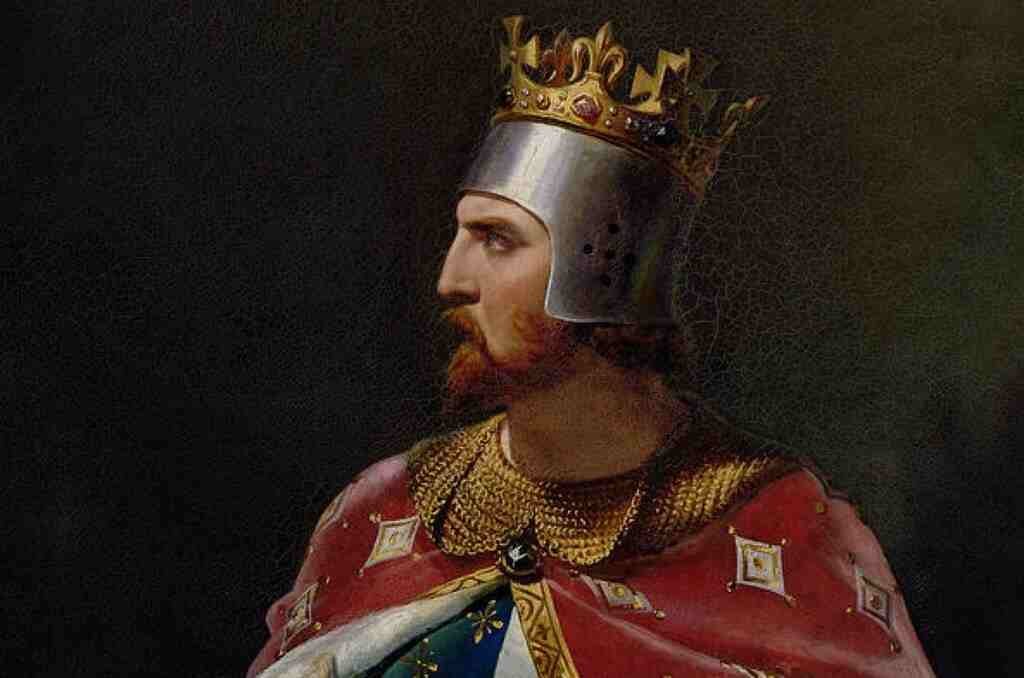King Richard I
Heir to the Plantagenet Empire, Richard the Lionheart is destined to be one of the most powerful rulers in the West. His reign lasted only ten years. A decade, however, led at full speed, from his coronation as King of England to his unexpected death in 1199. King Richard I was famous for his reputation as a great fighter and military leader, he was the main Christian commander during the third crusade.
Title: King of England, Duke of Normandy, Count of Anjou, Maine and Touraine
The felon (criminal) son
Born in 1157, Richard is the third son of Aliénor, Duchess of Aquitaine and Henry II Plantagenêt, King of England but also Duke of Normandy and Count of Anjou. At 14, he succeeded his mother as Count of Poitou and Duke of Aquitaine.
Unlike maternal ties, the relationship between father and son is chaotic. However, after the death of his two older brothers, Richard appears as the heir to the vast Plantagenet empire that his parents established. But Henry II does not seem ready to hand over, and cast doubt on the terms of his succession. Richard Coeur de Lion, impatient to reign, does not intend to remain in expectation and uncertainty. In 1188, at the age of 31, he revolted against his father and, in order for his business to succeed, allied himself with the main enemy of the Plantagenets, Philippe Auguste, the king of France.
The two allies seize one by one the cities of Anjou and Maine. Pursued relentlessly, abandoned by his barons, the old Henry II died, exhausted and demoralized, on April 6, 1189. A Welsh cleric, Giraud de Barri, related a supernatural anecdote: when Richard came to greet the remains of his father in the abbey de Fontevraud, the nostrils of the deceased begin to bleed. The prodigy stops as soon as he leaves.
Eldest son of Henry II, Richard the Lionheart was easily recognized as Duke of Normandy and then King of England in the summer of 1189. He inherited the Plantagenet empire which stretched from Scotland to the Pyrenees (France).
King of England, he didn’t speak English
Born in Oxford, Richard the Lionheart is arguably the least English of the kings of England. His origins are indeed doubly French: his mother is Eleanor of Aquitaine, and his father, Henri II Plantagenêt, was Duke of Anjou and Maine, Duke of Normandy and Aquitaine. Raised in the southwest of France, the young Richard speaks Latin and French perfectly. On the other hand, he does not understand a traitorous word of the language of his people, English. In ten years of reign, he stayed only six months in all in England, from August 13 to December 12, 1189 and from March 13 to mid-May 1194.
The Crusader in the Holy Land
For the new sovereign, however, there was no question of devoting himself to the government of his vast empire. Before being crowned, Richard made a vow to cross paths. Like his neighbour, the King of France Philippe Auguste. So off they went in July 1190 for the Third Crusade. A departure precipitated by the deterioration of the situation in the Middle East. Saladin, Sultan of Egypt, recaptured Jerusalem from the Franks a few years earlier.
After stops in Sicily and Cyprus, Richard and his army landed in the Holy Land on June 10, 1191. The arrival of these reinforcements ensured the first success of the Crusaders, the capture of the city of Acre (now the port of Israel). King Philippe Auguste then decides to leave the crusade, leaving the direction of operations to his former companion Richard the Lionheart with whom relations have clearly cooled.
The tactical qualities of the King of England allow him to reconquer the Palestinian coast and win the battle of Arsour against Saladin. But the main objective, Jerusalem, remains inaccessible. However, during this time, Philippe Auguste, back in France, is eyeing Normandy. For the King of England, ending the crusade is imperative. Yet he must conclude with a good outing. In the absence of a decisive military victory, the king negotiates with Saladin a last resort: the sultan recognizes the Christians’ possession of the coastal territories and accepts free access for pilgrims to Jerusalem. Richard Coeur de Lion can leave the Holy Land without shame on October 9, 1192.
The Knight King
The nickname “Lion” or “Coeur de Lion”, acquired during his lifetime, underlines Richard’s bravery, ardor in battle and indomitable character but also perhaps recalls his outburst. More generally, the King of England adopts and cultivates chivalrous values: courage, boldness, honor, generosity. Richard loves war, because it is an opportunity to demonstrate prowess. During the Crusade, we see him leading his army, charging with a spear or fighting his way through melee with his sword.
Jugglers and poets spread his exploits, his admirable words and his generous gestures. The era, lulled by the Chanson de Roland and the adventures of Arthur and the companions of the Round Table, is particularly sensitive to the strokes of brilliance of the “king-knight”.
The absent king
In ten years of reign, Richard the Lionheart will only stay six months in England despite his birth in Oxford. His fights, especially in the Holy Land, often forced him to move away from the kingdom. An absence prolonged by a long imprisonment.
Because the way back, from Palestine to the kingdom of England, is going badly. The King of England is forced to pass through hostile lands. At the end of the year 1192, despite his merchant disguise, he was taken prisoner in Vienna by Leopold, Duke of Austria, a Crusader prince with whom he hung on the day after the capture of Acre. The duke sells him to his lord, the Germanic emperor, Henry VI, who is just as ill-disposed towards the captive.
After thirteen months of imprisonment, the King of England was released at the price of a staggering ransom of 100,000 marcs of silver (34 tons). A long captivity from which Philippe Auguste benefits. The King of France agrees with the brother of the prisoner, Jean sans Terre, to share Normandy. The Capetian conquers Gisors, the Vexin Normand, Le Vaudreuil, Evreux, Le Neubourg before the lion can finally get out of its cage.
He was crowned twice
Richard inherits the throne of England, after the death of his father, Henry II Plantagenet, who died on July 6, 1189. A first coronation ceremony takes place on Sunday, September 3, at Westminster Abbey. Astonishing fact: after his return from captivity in 1194, his advisers came up with the idea of crowning Richard a second time, in order to give him a new legitimacy after the humiliation of detention. This new celebration took place on April 17, 1194, this time in Winchester.
The sponsor of Château-Gaillard
Shortly after his return to England, King Richard I the Lionheart went to war against the King of France. A long conflict of five years, interspersed only with truces never respected. By its wealth, by its proximity to Paris, Normandy is the privileged space of the confrontation between the two princes.
Aware of the fragility of his eastern border and the vulnerability of Rouen, the capital of the Duchy of Normandy, the King of England ordered the construction of a fortified complex at Andelys. It includes two castles: a first built at the top of a cliff (the famous Château-Gaillard in Normandy; is a region in north-west France), a second below on an island in the Seine. As a bonus, a triple row of piles bars the river.
Château Gaillard (Les Andelys) is a pure masterpiece of medieval military architecture. Sylvain Verlaine, CC BY-SA 3.0, via Wikimedia Commons
To accelerate the construction of this complex, the King of England must mobilize exceptional sums of money. The construction lasted about two years (1196-1198). Château-Gaillard impressed contemporaries. Its architecture, unprecedented in the West, is inspired by the latest experiences of fortifications, particularly seen in the Holy Land. Its keep, its double enclosure and its advanced work intended it to effectively resist the artillery of the time.
An incongruous (bizarre) death
Richard Coeur de Lion cannot judge the effectiveness of his fortress. As soon as a truce was concluded with the King of France, he turned away from Normandy for a new theater of operation. Viscount Aymar de Limoges rebelled against him. The rebellious baron notably owns the castle of Châlus-Chabrol which Richard comes to besiege in person. On March 26, 1199, in the evening, the king inspected the defenses in front of the ditches. He recklessly moves away from the large wooden shield that is carried in front of him. From the top of the rampart, an enemy crossbowman took the opportunity to fire a crossbow bolt at him, which crashed into Richard’s shoulder. The clumsy intervention of a surgeon aggravates the evil. Gangrene sets in. On April 6, Richard dies. He was only 42 years old.
Except to direct them against the infidels, the pope had condemned the use of crossbows because of their disloyal character. These weapons strike from afar and anonymously. The princes did not apply the papal ban, aware of the effectiveness of the jets. Richard Coeur de Lion has also multiplied the arrow slits in the towers of Château-Gaillard.
That a king dies in war, nothing infamous but Richard, the knight king, succumbs not during a battle but following a cowardly crossbow shot. The meaning of this inglorious death questions contemporaries. The fortress of Châlus-Chabrol was nonetheless taken and the murderous crossbowman was flayed alive before being hanged.
Victim of a sniper, he died in his mother’s arms
In March 1199, Richard besieged the castle of Châlus (Haute-Vienne), a small fortress whose ruins can still be seen today. On the 26th, during an inspection at the foot of the citadel defended by about forty men, the king was targeted by a crossbowman. A bolt, fired from the top of the walls, shattered his left shoulder. Despite the rapid intervention of a surgeon, gangrene appears the next day. Eleanor of Aquitaine, alerted, rushes from Fontevraud, 200 km away, to his bedside. Richard died on April 6 in his mother’s arms.
His body was dismembered after his death
The day after his death, as was then the tradition, the royal remains were dismembered and the pieces shipped: the brain and entrails were transferred to Charroux, on the border of Poitou and Limousin. . The heart was sent to Rouen. While the rest of the body was buried in Fontevraud (Maine-et-Loire), Palm Sunday, April 11, 1199.
Kings and Queens of England and Britain | Monarchs of England and Scotland
Sources: PinterPandai, Britannica, TheCollector, World History
Photo credit: Merry-Joseph Blondel, Public domain, via Wikimedia Commons




